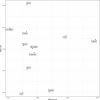Low-Frequency Blood Group Antigens in Switzerland
- PMID: 30283273
- PMCID: PMC6158591
- DOI: 10.1159/000490714
Low-Frequency Blood Group Antigens in Switzerland
Abstract
Background: High-frequency blood group antigens (HFA) are present in >90% of the human population, according to some reports even in >99% of individuals. Therefore, patients lacking HFA may become challenging for transfusion support because compatible blood is hardly found, and if the patient carries alloantibodies, the cross-match will be positive with virtual every red cell unit tested.
Methods: In this study, we applied high-throughput blood group SNP genotyping on >37,000 Swiss blood donors, intending to identify homozygous carriers of low-frequency blood group antigens (LFA).
Results: 326 such individuals were identified and made available to transfusion specialists for future support of patients in need of rare blood products.
Conclusion: Thorough comparison of minor allele frequencies using population genetics revealed heterogeneity of allele distributions among Swiss blood donors which may be explained by the topographical and cultural peculiarities of Switzerland. Moreover, geographically localized donor subpopulations are described which contain above-average numbers of individuals carrying rare blood group genotypes.
Keywords: Blood group allele; Blood groups; High-frequency antigen; Low-frequency antigen; Population genetics; Rare donor panel/program; Rare/molecular blood group; Switzerland.
Figures




References
-
- Woodfield G, Poole J, Nance ST, Daniels G. A review of the ISBT rare blood donor program. Immunohematology. 2004;20:244–248. - PubMed
-
- Daniels G. 3rd ed. Oxford: Blackwell; 2013. Human Blood Groups.
-
- International Society of Blood Transfusion Committee on Terminology for RBC Surface Antigens. 2018 www.isbtweb.org/working-parties/red-cell-immunogenetics-and-blood-group-.... (last accessed June 27, 2018)
-
- Meyer S, Vollmert C, Trost N, Bronnimann C, Gottschalk J, Buser A, et al. High-throughput Kell, Kidd, and Duffy matrix-assisted laser desorption/ionization, time-of-flight mass spectrometry-based blood group genotyping of 4000 donors shows close to full concordance with serotyping and detects new alleles. Transfusion. 2014;54:3198–3207. - PubMed
LinkOut - more resources
Full Text Sources
Other Literature Sources

